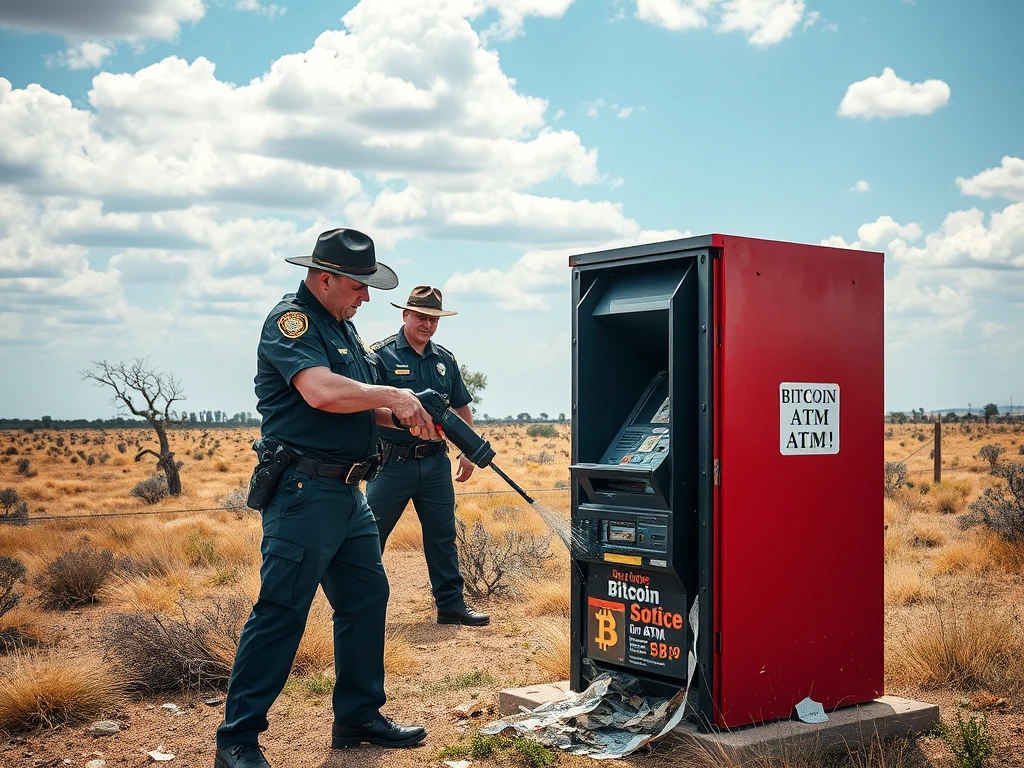Shocking Texas Police Recovery: Crypto ATM Cut Open After $25K Bitcoin Scam

Imagine losing a significant amount of money to a scammer, only for law enforcement to take unprecedented action to get it back. That’s exactly what happened in Jasper County, Texas, involving a crypto ATM and a substantial sum lost to a fraudulent scheme. This incident has not only brought relief to a scammed family but also ignited a fierce debate within the crypto community about property rights and police tactics.
How a Bitcoin Scam Led to Drastic Action
The situation unfolded when a family in Jasper County fell victim to a scammer impersonating a government employee. The fraudster convinced the family they owed $25,000 in fines and instructed them to deposit the money into a specific Bitcoin address. Believing the threat, the family used a local crypto ATM, reportedly operated by Bitcoin Depot, to transfer the funds.
Upon learning of the scam, Jasper County Sheriff Chuck Havard secured a search warrant for the ATM. Instead of pursuing digital tracing methods, the sheriff’s department took a direct approach: they used power tools to cut the machine open. This led to the physical recovery of approximately $32,000 from inside the ATM, which included the $25,000 lost by the family.
The Police Recovery Sparks Debate
While the family was undoubtedly relieved by the swift police recovery of their funds, the method used has drawn criticism from crypto users online. Many questioned the legality and appropriateness of destroying private property (the ATM) to recover funds deposited by a user, especially if the ATM operator was not involved in the scam.
- One user compared it to seizing money from a retail store’s register because a scammer instructed someone to buy gift cards there.
- Others expressed concern that law enforcement might damage innocent third-party property.
Sheriff Havard defended his actions, stating his department would use every resource to protect citizens from scammers. However, he acknowledged the complexity of cases involving crypto scams and noted that the scammer in this case has yet to be located.
Rising Concerns Over Crypto Scams and ATMs
This Texas incident highlights a growing national and international concern regarding the use of crypto ATMs in scams. Scammers often favor these machines because they allow for quick, irreversible transfers and can be intimidating for less tech-savvy individuals targeted by fraud.
Recent data and actions underscore this trend:
- The FBI reported nearly 11,000 complaints and over $246 million lost to crypto ATM scams in 2024 so far, a significant increase from the previous year.
- Spokane, Washington, recently banned crypto ATMs citing their connection to scam activity.
- Australia implemented a $3,250 limit on cash deposits/withdrawals at crypto ATMs to curb fraudulent use.
These regulatory responses indicate increasing pressure on crypto ATM operators and users to address the misuse of these machines by criminals.
Challenges in Combating Crypto Scams
Sheriff Havard correctly pointed out that pursuing crypto scams is challenging. The decentralized nature of cryptocurrencies, the speed of transactions, and the difficulty in identifying wallet owners make traditional investigative methods less effective. While physical recovery from an ATM bypasses some of these digital hurdles, it raises other legal and property concerns.
Finding a balance between protecting citizens from fraud and respecting the property rights of businesses operating crypto ATMs remains a complex issue for law enforcement and regulators.
Summary: An Unconventional Recovery Method
The Jasper County case where Texas police cut open a crypto ATM to recover funds lost in a Bitcoin scam is an unusual example of law enforcement intervention. While successful in retrieving the family’s money, the method has fueled debate about the lengths authorities should go to combat crypto scams and the potential impact on legitimate businesses. As crypto use grows, the challenge of preventing fraud and finding effective, legally sound recovery methods will continue to be a critical focus for police and regulators alike.









